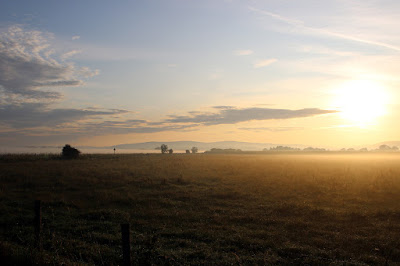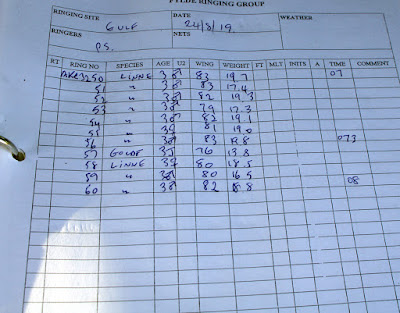At last, the dogged Jet Stream that brought three weeks of wind and rain has finally moved north and left things looking more settled.
Saturday morning was indeed a “cracker” for birding or ringing with a clear sky, little wind, and no rain in the forecast. I was up and about early so after a piece of toast and a mug of Tetley Tea I drove to Gulf Lane, Cockerham for a crack at the Linnets as part of Project Linnet 2019/2020.
Cockerham Dawn
In the week there had been 60/80 Linnets and several Tree Sparrows feeding in the field of seed crop but it had been far too wet and windy for other than a count.
Soon after first light and 0630 heading through the crop I noted how 50/60 Linnets were already in there. Either they had roosted in the thick cover so as to get an early breakfast or they had roosted very close-by, perhaps in the thick bramble that lines the adjacent ditch.
By 0830 the flock had grown to between 160/185 birds, 99% of them Linnets with one or two Goldfinch and Tree Sparrows. This is a good number for so early in the autumn.
It was a reasonable catch of 11 birds, 10 Linnets and a single Goldfinch. Of the Linnets, eight were male and two female. The Goldfinch could not be sexed as it was clearly a youngster from a second brood of July or August rather than a spring chicken.
All eleven birds proved to be juveniles/birds of the year - Aged “3” in ringers’ data code.
Field Sheet
Linnet - first year male
Goldfinch - juvenile/first year
Linnet - first year/juvenile male
Linnet - first year/juvenile female
It was about 0830 when without warning, a Green Sandpiper flew calling from the adjacent ditch that lines the western edge of the plot. The sandpiper flew off over the farm and I didn’t see it again. This was an unexpected interlude and a “first” for the site. Every record is helpful in proving the worth of this plot and its value as a feeding place for what may prove to be a surprising number and range of species.
Green Sandpiper
Other species noted this morning – 6 Tree Sparrow, 4 Stock Dove, 1 Little Egret, 1 Grey Heron, 1 Reed Bunting.
A reminder from the BTO as to why we are continuing with the Linnet project, now in its fourth winter.
“A Red-listed bird of mainly farmland, the Linnets’ abundance fell rapidly in the UK in the late 1960s, and again between the mid 1970s and mid 1980s, but this decrease has been followed by a long period of relative stability. Numbers have fallen further since the start of Breeding Bird Survey (BBS) in 1994. The BBS map of change in relative density between 1994-96 and 2007-09 indicates that in both Britain and Northern Ireland there has been decrease in eastern regions and increase in the west. There has been widespread moderate decline across Europe since 1980.”
Linnet 1966 - 2017 Courtesy BTO
And while we are on the subject of farmland, there's an interesting and revealing article here about the European Union’s Common Agricultural Policy of which Britain is a part. Hopefully for not much longer - The CAP doesn't fit.
Back soon with more news, views and pictures if the weather holds.
Linking this post to Anni, who's birding in Texas.
Linking this post to Anni, who's birding in Texas.
















.JPG)






.jpg)












13 comments:
I always learn so much -sandhill cranes,doves all sorts, cardinals,, sparrows,whistler ducks, mockingbirds and every now and then a crow or blue jay in my yard now
Any day that includes a surprise Sandpiper is a good day!
Smart Linnets to figure out the early (or overnight?) bird gets the seed in the thickly grown field. Best of luck on your continuing project to gain data on the species.
Unfortunately, Americans have been watching the decline of small family farms for decades as huge Agribusiness figured out how to game the subsidy system and has now taken over the food supply of the world. We wish you all the best in breaking your EU bonds and hope it will some day help Britain regain control over its own farming (not to mention overall quality of life).
Bureaucracy is a plague.
Good to hear your weather is being more birder-friendly!
Hello Phil: I am sure that you experienced a good deal of relief to finally have some good weather. Days on end of gloom and rain can become very depressing. The Green Sandpiper was a pleasant surprise, no doubt; a new species for a familiar territory is always pleasing. And you got in some ringing too. Not a huge number of birds but evidence of breeding success, and that is a good sign. How obliging those birds were to meander into your nets. We started our own fall session this morning with modest success and I expect to have a report on those activities in a day or two. Perhaps tomorrow you will be at it again.
I'm happy to hear you had good weather to get out too! The Green Sandpiper is gorgeous! What a nice sighting! And how good to ring so many young ones! We love birds and hearing of your successes!
What a neat experience. Thanks so much to share the pictures of these birds!
Love the juvenile Goldfinch image. And I'm not familiar with 'stock dove' ... will have to utilize Google after I leave here. Great numbers seen on your day out...and what sounds like perfect weather!! (Stunning sunrise photo...my favorite time of day)
Love the post this week...thanks for joining us this week at I'd Rather B Birdin'.
very sad about Linnet population, hope, the population back to normal soon....
Lovely juvenile Goldfinch...colorful.
So pleased the weather finally improved for you.
Great photographs here and amazing to see the green sandpiper.
All the best Jan
Phil - how English to start with toast and Tetley tea! Glad the weather improved, and what a lovely sandpiper picture!
The goldfinch, always a favourite.
Lovely! And your posts always contain some fascinating information.
Thanks for linking up at https://image-in-ing.blogspot.com/2019/08/pass-jelly.html
I second Fun60 comment. I love the finches!
http://travelingbugwiththreeboys-kelleyn.blogspot.com/
I enjoy looking at birds , but I am not knowledgable. Thanks for the info and lovely photos
Post a Comment